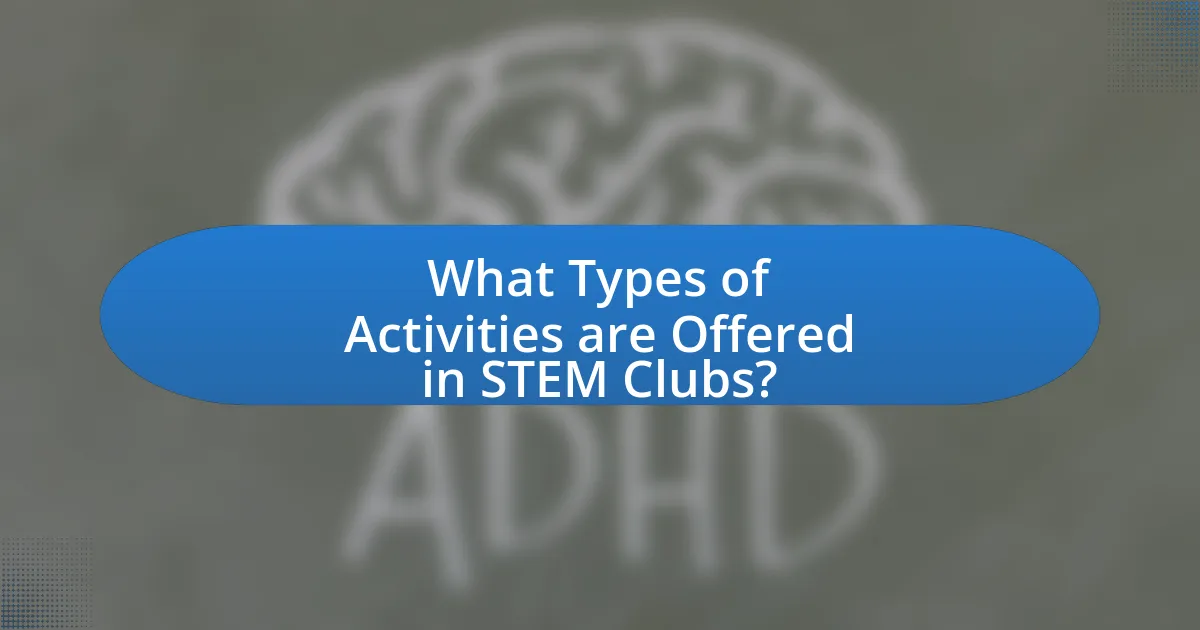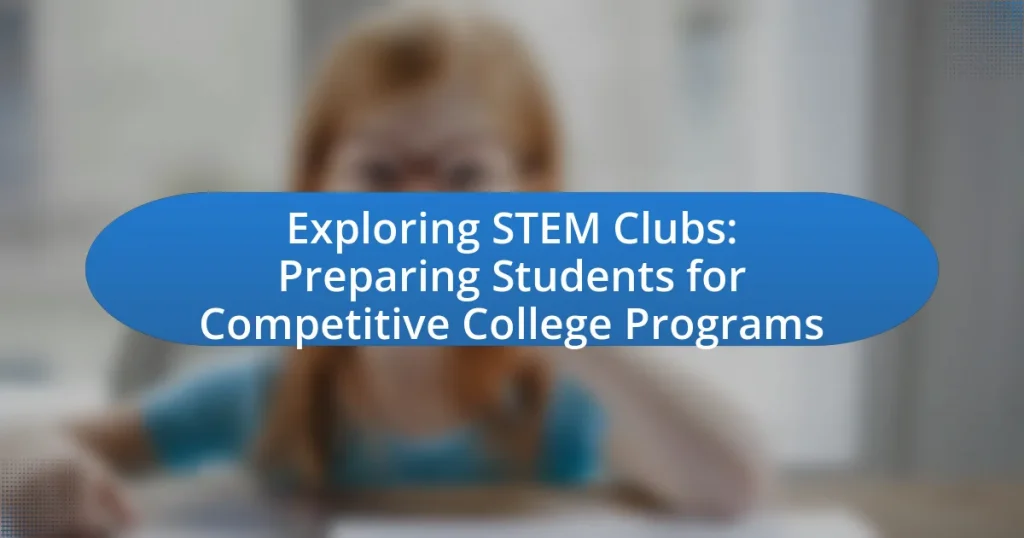STEM clubs are extracurricular organizations that focus on science, technology, engineering, and mathematics, aiming to engage students in hands-on learning and collaborative projects. These clubs enhance critical thinking, problem-solving skills, and teamwork abilities, significantly improving students’ academic performance and increasing their likelihood of pursuing STEM-related degrees. The article explores the various activities offered in STEM clubs, the skills students gain, and the importance of these clubs in college preparation and career exploration. Additionally, it discusses best practices for running successful STEM clubs, creating inclusive environments, and evaluating the effectiveness of club activities.

What are STEM Clubs and their Purpose?
STEM clubs are extracurricular organizations focused on science, technology, engineering, and mathematics, designed to engage students in hands-on learning and collaborative projects. Their purpose is to foster interest in STEM fields, enhance problem-solving skills, and prepare students for future academic and career opportunities in these areas. Research indicates that participation in STEM clubs can significantly improve students’ understanding of complex concepts and increase their likelihood of pursuing STEM-related degrees, as evidenced by a study from the National Science Foundation which found that students involved in such clubs scored higher on standardized tests in math and science compared to their peers.
How do STEM Clubs contribute to student development?
STEM Clubs contribute to student development by enhancing critical thinking, problem-solving skills, and teamwork abilities. Participation in these clubs allows students to engage in hands-on projects and experiments, fostering a deeper understanding of scientific and mathematical concepts. Research indicates that students involved in STEM activities show improved academic performance in related subjects, with a study from the National Science Foundation revealing that students in STEM programs are 1.5 times more likely to pursue STEM degrees in college. Additionally, STEM Clubs provide networking opportunities and mentorship, which are crucial for personal and professional growth, further preparing students for competitive college programs.
What skills do students gain from participating in STEM Clubs?
Students gain critical thinking, problem-solving, teamwork, and technical skills from participating in STEM Clubs. These clubs provide hands-on experiences that enhance analytical abilities and foster collaboration among peers. For instance, a study by the National Science Foundation found that students involved in STEM activities showed a 20% increase in their problem-solving skills compared to those who did not participate. Additionally, STEM Clubs often require students to work on projects that involve coding, engineering, and scientific research, which further develops their technical competencies.
How do STEM Clubs foster teamwork and collaboration?
STEM Clubs foster teamwork and collaboration by engaging students in group projects that require collective problem-solving and communication. These clubs often involve hands-on activities, such as building robots or conducting experiments, which necessitate sharing ideas and dividing tasks among members. Research indicates that participation in STEM-related group activities enhances students’ ability to work effectively in teams, as evidenced by a study published in the Journal of Educational Psychology, which found that students involved in collaborative STEM projects demonstrated improved interpersonal skills and higher academic performance.
Why are STEM Clubs important for college preparation?
STEM clubs are important for college preparation because they provide students with hands-on experience in science, technology, engineering, and mathematics, which are critical fields for higher education. Participation in these clubs enhances problem-solving skills, fosters teamwork, and encourages innovation, all of which are essential for success in college-level STEM courses. Research indicates that students involved in extracurricular STEM activities are more likely to pursue STEM degrees; for instance, a study by the National Science Foundation found that students engaged in STEM clubs demonstrate higher academic performance and increased interest in STEM careers.
What role do STEM Clubs play in enhancing college applications?
STEM Clubs significantly enhance college applications by demonstrating a student’s commitment to science, technology, engineering, and mathematics. Participation in these clubs showcases leadership skills, teamwork, and a proactive approach to learning, which are highly valued by college admissions committees. Research indicates that students involved in extracurricular activities, such as STEM Clubs, often have higher GPAs and standardized test scores, making them more competitive applicants. Additionally, these clubs provide opportunities for students to engage in projects, competitions, and community outreach, further enriching their profiles and illustrating their passion for STEM fields.
How do STEM Clubs help students explore potential career paths?
STEM Clubs help students explore potential career paths by providing hands-on experiences in science, technology, engineering, and mathematics fields. These clubs facilitate project-based learning, allowing students to engage in real-world applications of STEM concepts, which enhances their understanding of various careers. For instance, participation in robotics competitions or coding workshops exposes students to engineering and computer science careers, while science fairs can spark interest in research and healthcare professions. Research indicates that students involved in extracurricular STEM activities are more likely to pursue STEM degrees and careers, as evidenced by a study from the National Science Foundation, which found that students who participated in STEM clubs showed a 20% increase in interest in STEM fields compared to their peers.

What Types of Activities are Offered in STEM Clubs?
STEM clubs offer a variety of activities designed to engage students in science, technology, engineering, and mathematics. These activities typically include hands-on experiments, coding workshops, robotics competitions, engineering design challenges, and math problem-solving sessions. For instance, students may participate in building and programming robots for competitions like FIRST Robotics, which fosters teamwork and technical skills. Additionally, clubs often organize guest speaker events with professionals in STEM fields, providing real-world insights and inspiration. Research indicates that participation in such activities enhances critical thinking and problem-solving skills, which are essential for success in competitive college programs.
How do hands-on projects benefit students in STEM Clubs?
Hands-on projects benefit students in STEM Clubs by enhancing practical skills and fostering deeper understanding of theoretical concepts. Engaging in these projects allows students to apply scientific and mathematical principles in real-world scenarios, which reinforces learning and retention. Research indicates that students involved in hands-on activities demonstrate improved problem-solving abilities and critical thinking skills, essential for success in competitive college programs. For instance, a study published in the Journal of STEM Education found that students participating in hands-on projects scored 20% higher on assessments related to STEM subjects compared to those who engaged solely in traditional learning methods. This evidence underscores the effectiveness of hands-on projects in preparing students for advanced academic challenges.
What are some examples of successful projects in STEM Clubs?
Successful projects in STEM Clubs include robotics competitions, where students design and build robots to compete in challenges, and science fairs, where members conduct experiments and present their findings. For instance, the FIRST Robotics Competition engages high school students in engineering and programming, fostering teamwork and problem-solving skills. Additionally, projects like building solar-powered vehicles or creating mobile apps have proven effective in enhancing technical skills and creativity among participants. These initiatives not only promote STEM education but also prepare students for future academic and career opportunities in competitive college programs.
How do competitions enhance the learning experience in STEM Clubs?
Competitions enhance the learning experience in STEM Clubs by providing students with practical, hands-on opportunities to apply theoretical knowledge in real-world scenarios. These events foster critical thinking, teamwork, and problem-solving skills, which are essential for success in STEM fields. Research indicates that students who participate in competitions demonstrate improved academic performance and increased engagement in STEM subjects, as they are motivated to excel and innovate. For instance, a study published in the Journal of STEM Education found that students involved in competitive STEM activities showed a 20% increase in their understanding of complex concepts compared to their peers who did not participate. This evidence underscores the significant impact that competitions have on enriching the educational experience within STEM Clubs.
What resources are available for STEM Clubs?
STEM Clubs have access to a variety of resources including funding opportunities, educational materials, mentorship programs, and partnerships with local businesses and universities. Funding can be sourced from grants specifically aimed at supporting STEM education, such as those provided by the National Science Foundation, which allocates millions annually to enhance STEM learning. Educational materials include online platforms like NASA’s STEM Engagement, which offers lesson plans and activities, and organizations like the Society of Women Engineers that provide resources tailored for young learners. Mentorship programs often connect students with professionals in STEM fields, enhancing their learning experience and career guidance. Additionally, partnerships with local businesses and universities can provide clubs with access to facilities, equipment, and expertise, further enriching the educational experience.
How can clubs access funding and sponsorships?
Clubs can access funding and sponsorships by applying for grants, seeking partnerships with local businesses, and organizing fundraising events. Many organizations, such as the National Science Foundation, offer grants specifically for STEM initiatives, which can provide substantial financial support. Additionally, local businesses often look to support community programs in exchange for advertising opportunities, making them potential sponsors. Fundraising events, such as competitions or workshops, can also generate revenue while promoting the club’s activities. These methods are effective as they leverage community resources and established funding channels to enhance club operations and student engagement in STEM fields.
What partnerships can enhance the effectiveness of STEM Clubs?
Partnerships with local universities, tech companies, and community organizations can significantly enhance the effectiveness of STEM Clubs. Collaborating with local universities allows students to access resources, mentorship, and expertise from faculty and graduate students, fostering a deeper understanding of STEM fields. Tech companies can provide real-world insights, internships, and sponsorships, which help students apply their knowledge in practical settings. Community organizations often offer additional support, resources, and outreach opportunities, creating a more inclusive environment for diverse student participation. These partnerships collectively contribute to a richer educational experience, preparing students for competitive college programs in STEM disciplines.

How can Students Maximize Their Experience in STEM Clubs?
Students can maximize their experience in STEM clubs by actively participating in projects, collaborating with peers, and seeking leadership roles. Engaging in hands-on projects allows students to apply theoretical knowledge, enhancing their understanding of STEM concepts. Collaboration fosters teamwork skills and exposes students to diverse perspectives, which is crucial in STEM fields. Taking on leadership roles helps develop organizational and communication skills, preparing students for future academic and professional challenges. Research indicates that students involved in extracurricular STEM activities are more likely to pursue STEM degrees and careers, as these experiences build confidence and competence in the subject matter.
What strategies can students use to engage more effectively in STEM Clubs?
Students can engage more effectively in STEM Clubs by actively participating in hands-on projects and collaborating with peers. Engaging in practical activities fosters a deeper understanding of STEM concepts and encourages teamwork, which is essential for problem-solving in real-world scenarios. Research indicates that students who participate in collaborative projects are more likely to develop critical thinking skills and retain information longer. Additionally, attending workshops and guest lectures can enhance their knowledge and inspire innovation, as exposure to industry professionals provides insights into current trends and applications in STEM fields.
How can students take on leadership roles within their clubs?
Students can take on leadership roles within their clubs by actively participating in club activities, volunteering for officer positions, and initiating projects that align with the club’s goals. Engaging in discussions, proposing new ideas, and demonstrating commitment can lead to opportunities for leadership. For instance, students who organize events or lead meetings often gain recognition and trust from peers, which can result in being elected to formal leadership roles. Research indicates that students involved in leadership positions in clubs develop essential skills such as teamwork, communication, and problem-solving, which are critical for success in competitive college programs.
What networking opportunities should students pursue through STEM Clubs?
Students should pursue networking opportunities such as mentorship programs, industry guest speaker events, and collaborative projects through STEM Clubs. These activities facilitate connections with professionals in the field, allowing students to gain insights into career paths and industry trends. For instance, mentorship programs often pair students with experienced professionals who can provide guidance and support, enhancing students’ understanding of real-world applications of their studies. Additionally, events featuring guest speakers from various STEM industries can expose students to diverse career options and networking possibilities. Collaborative projects, often involving partnerships with local businesses or universities, enable students to work on practical problems, fostering teamwork and communication skills while expanding their professional networks.
What are the best practices for running a successful STEM Club?
To run a successful STEM Club, establish a clear mission and set specific goals that align with student interests and community needs. Engaging students through hands-on projects, competitions, and collaboration with local organizations fosters enthusiasm and practical skills. Research indicates that clubs with structured activities and mentorship programs enhance student participation and learning outcomes, as seen in studies by the National Science Foundation, which highlight the importance of experiential learning in STEM education. Regularly evaluating club activities and seeking feedback from members ensures continuous improvement and relevance to participants’ aspirations.
How can club leaders create an inclusive environment for all members?
Club leaders can create an inclusive environment for all members by implementing policies and practices that promote diversity and equity. This includes actively recruiting members from various backgrounds, ensuring that all voices are heard during meetings, and providing resources that cater to different learning styles and needs. Research shows that diverse teams are more innovative and effective; for instance, a study by McKinsey & Company found that companies with higher diversity levels are 35% more likely to outperform their peers. By fostering an atmosphere of respect and collaboration, club leaders can enhance participation and engagement among all members, ultimately leading to a more enriching experience in STEM clubs.
What methods can be used to evaluate the success of STEM Club activities?
To evaluate the success of STEM Club activities, methods such as participant surveys, project outcomes assessment, and attendance tracking can be utilized. Participant surveys gather feedback on member satisfaction and perceived learning, providing quantitative and qualitative data on the effectiveness of activities. Project outcomes assessment involves measuring the results of specific projects against predefined goals, such as the completion of a competition or the development of a prototype, which can indicate the club’s impact on skill development. Attendance tracking offers insights into engagement levels and retention rates, reflecting the club’s ability to maintain interest among members. These methods collectively provide a comprehensive view of the STEM Club’s effectiveness in fostering skills and interest in STEM fields.
What tips can help students prepare for competitive college programs through STEM Clubs?
Students can prepare for competitive college programs through STEM Clubs by actively participating in hands-on projects, collaborating with peers, and seeking mentorship from experienced professionals. Engaging in hands-on projects allows students to apply theoretical knowledge in practical scenarios, enhancing their problem-solving skills and creativity. Collaboration fosters teamwork and communication skills, which are essential in college and professional environments. Additionally, mentorship provides guidance and insights into the college application process and career pathways, helping students make informed decisions. Research indicates that students involved in extracurricular activities, such as STEM Clubs, often have higher academic performance and increased college readiness, as they develop critical skills and a strong network.


